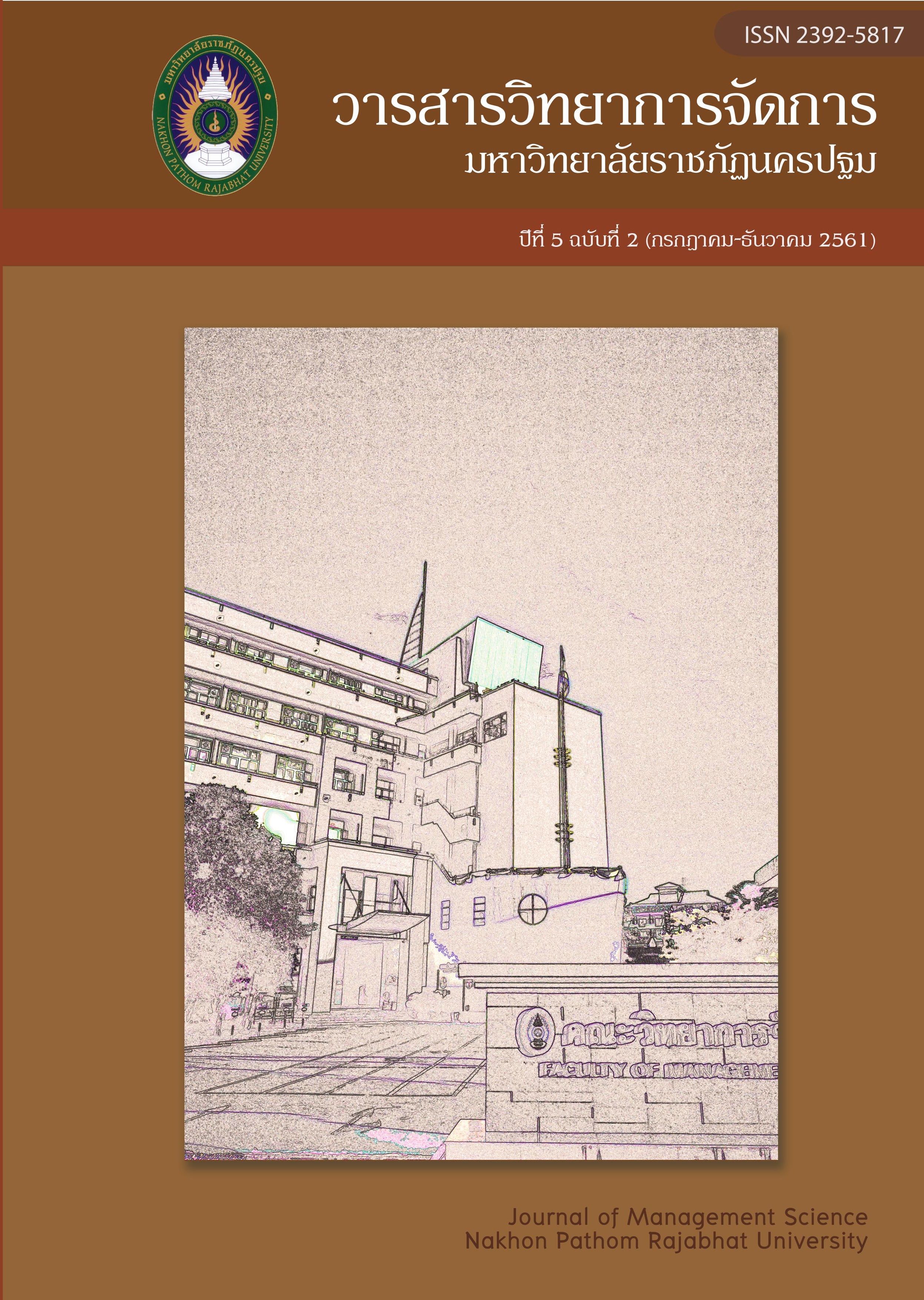Development guidelines of marketing mix strategy of clean food business among women of working age in Ratchaburi Province
Main Article Content
Abstract
This research aimed to: 1) compare the clean food consumption behavior of women of working age, as classified by personal factors; 2) study the marketing mix affecting clean food consumption behavior of women of working age; and 3) analyze the guidelines for developing marketing mix strategy of clean food business among women of working age. The research sample was 400 women who were between 19–60 years of age and resided in Ratchaburi Province derived by accidental sampling, and 10 clean food business owners for the interview derived by purposive sampling.The research instruments were a questionnaire and an in-depth interview constructed by the researcher. The questionnaire was with the IOC content validity between 0.67-1.00.The internal coefficients were 0.725 for product, 0.728 for price, 0.787 for place and 0.703 forpromotion. Data were analyzed with percentage, mean, standard deviation, t-test, one-way analysis of variance, stepwise multiple regression and content analysis.
The research results were as follows:
1. Overall, the women of working age as classified by age, education level, occupation, average monthly income, and number of family members had different clean food consumption behavior with significant difference at .05. However, there was no difference among those with deference in status.
2. The marketing mix in the aspects of product, place, and promotion together predicted clean food consumption behavior with the percentage of 11.60 with significant difference of .05. The regression equation was Ŷ1= 1.852 + 0.392(x1) + 0.067 (x2) + 0.341 (x3) + 0.328 (x4).
3. The guidelines for developing marketing mix strategy of clean food business among women of working age were as follows: 1) In product aspect, clean food restaurants should give importance to cleanliness and freshness of the menu. The food should contain nutritive value with delicious taste. 2) Restaurant should set the price in accordance with food quality and the price should be acceptable to consumers. 3) Regarding place of distribution, restaurants should focus on delivery service for consumers’ easy access and convenience. Additionally, online purchasing should be organized, so that consumers could contact with restaurants easily. 4) In the promotion aspect, restaurants should organize promotion to create regular customers, as well as attract new customers to increase sale volume.
Article history : Received 18 July 2017
Revised 12 October 2017
Accepted 20 October 2017
SIMILARITY INDEX = 0.91
Article Details
The views and opinions of the article appearing in this journal are those of the author. It is not considered a view and responsibility of the editorial staff.
References
กรมอนามัย. (2558). ภาวะโภชนาการของวัยผู้ใหญ่ (19-60 ปี). [ออนไลน์]. ค้นเมื่อ 6 ตุลาคม 2558, จาก https://www.foodandfamilynrs.blogspot.com/2012/11/19-60-5-19-60-19-60.html.
กามีละฮ หะยียะโกะ. (2554). ปัจจัยส่วนประสมทางการตลาดที่มีผลต่อพฤติกรรมการบริโภคน้ำนมถั่วเหลืองของผู้บริโภคในเขต 3 จังหวัดชายแดนภาคใต้. การค้นคว้าอิสระปริญญาบริหารธุรกิจมหาบัณฑิต บัณฑิตวิทยาลัย มหาวิทยาลัยราชภัฏยะลา.
จันทกานต์ รติชน. (2557). ปัจจัยที่มีอิทธิพลต่อการตัดสินใจเลือกซื้ออาหารเพื่อสุขภาพสปาฟู้ดส์ของผู้บริโภคกลุ่มวัยทำงานในกรุงเทพมหานคร. การศึกษาค้นคว้าอิสระปริญญาบริหารธุรกิจมหาบัณฑิต สาขาวิชาการตลาด บัณฑิตวิทยาลัย มหาวิทยาลัยรังสิต.
ชนิดาภา จุมพล. (2558). โครงการร้านอาหารเพื่อสุขภาพตามหมู่เลือดเพื่อสุขภาพ (EAT MEET FUN, Healthy Social Cafe). การค้นคว้าอิสระนิเทศศาสตรมหาบัณฑิต สาขาวิชาการบริหารธุรกิจบันเทิงและ การผลิตบัณฑิตวิทยาลัย. มหาวิทยาลัยกรุงเทพ.
สง่า ดามาพงษ์. (2557). ‘เพื่อสุขภาพฟู้ด’ อีกมิติของการกินเพื่อสุขภาพ. [ออนไลน์]. ค้นเมื่อ 6 ตุลาคม 2558, จาก https://www.thaihealth.or.th/Content/25051-‘เพื่อสุขภาพฟู้ด’%20อีกมิติของการกินเพื่อสุขภาพ.html
สำนักงานสถิติจังหวัดราชบุรี. (2559). จำนวนประชากรแยกรายอายุ จังหวัดราชบุรี. [ออนไลน์]. ค้นเมื่อ 21 กันยายน 2559, จาก https://stat.dopa.go.th/stat/statnew/upstat_age_disp.php
อดุลย์ จาตุรงคกุล. (2551). กลยุทธ์การตลาด. กรุงเทพมหานคร : มหาวิทยาลัยธรรมศาสตร์.
Belch, George E. & Michael A. Belch. (2005). Advertising and promotion : an integrated marketing communications Perspective (6thed). Boston : McGraw-Hill.
Cronbach, L. (1974). Essentials of psychological testing. New york : Harper & Row Publisher.
Hanna, N. & Wozniak, R. (2001). Consumer behavior : An applied approach. Upper Saddle River. NJ, Prentice Hall.
Kotler, P. (2009). Marketing management. : analysis, planning implementation and control (12thed.). New Jersey : Pearson Education.
Kotler, P., & Armstrong, G. (2010). Principles of Marketing (13thed.). Pearson Education.
Krejcie, R. V. & Morgan, D. W. (1970). Determining Sample Size for Research Activities. Educational and Psychological Measurement, 30(3), 607-610.
Lamb, C.W., Hair, J.F. & McDaniel, C. (2009). Marketing. (5thed.). California : South Western College.
Schiffman, L. G., & Kanuk, L. L. (2005). Consumer Behavior. (8thed.). Upper Saddle River, NJ : Pearson Prentice Hall.
Wheelen L. T. & Hunger J. D. (2012). Strategic management and business policy: Toward Global Sustainability (13th ed.). Pearson Education.


